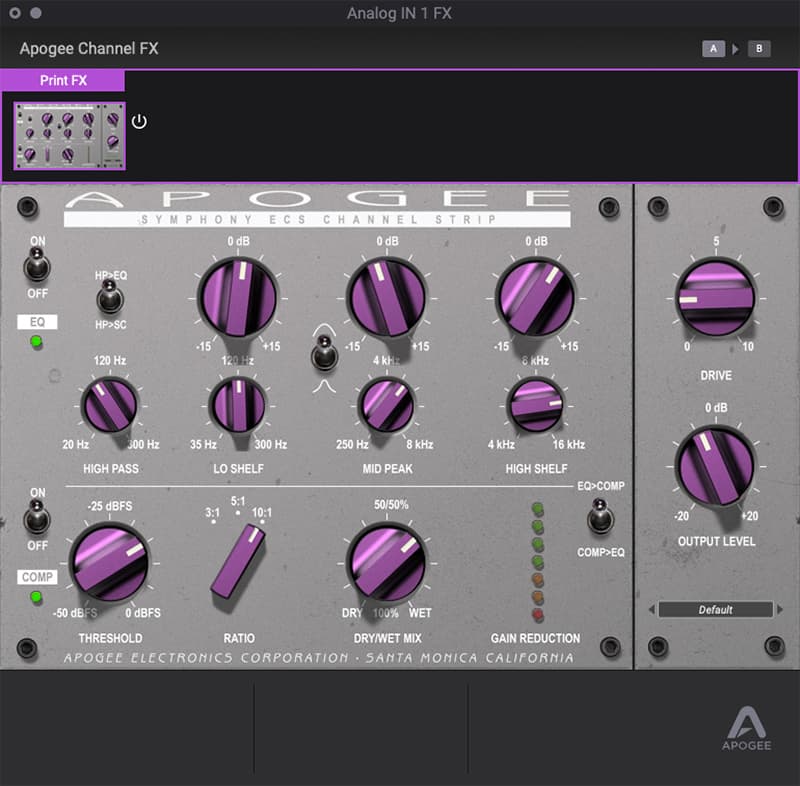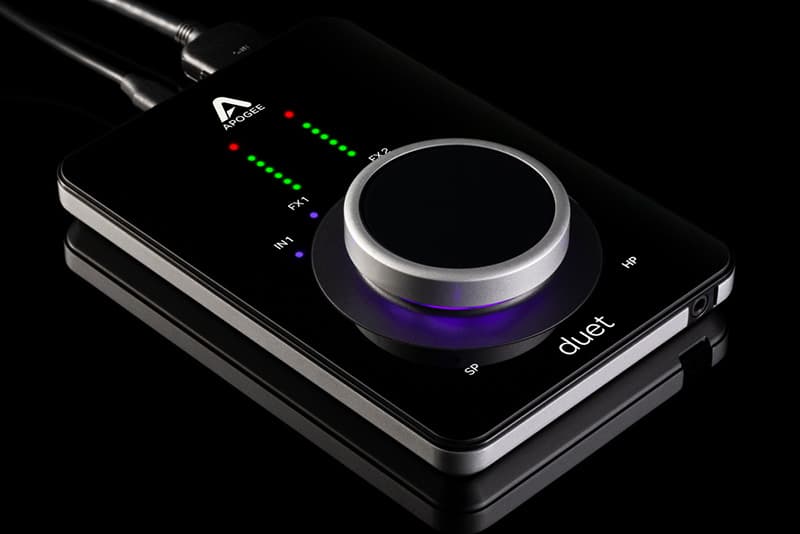
Review: Apogee Duet 3
14 years after the original, Duet 3 again sets the tone for everything a low-profile desktop interface should look and sound like.
Apogee has held a lead in the digital audio conversion game for decades. Back in the day (read: last century), the company’s military-grade audio converters were top-shelf, deep-pocket units designed to offer some of the best available analogue-to-digital (and vice versa) conversion possible. By the mid-2000s the company began distilling its secret sauce into smaller two- and four- and eight-channel devices aimed toward budget conscious recordists. Units such as the eight-channel Ensemble and dual-channel Duet brought Apogee audio conversion to the masses. In fact, I ditched more prestigious converters and interfaces years ago for a couple of Apogee Ensembles and never looked back. They’re ace!
For those simply requiring a couple of inputs, headphones and monitoring, the Duet series is ideal. Version 3 of the Duet is on my bench today, and I gotta say, it brings a bunch of surprises. Like many manufacturers these days, Apogee has integrated onboard DSP functionality, which I’ll get to a little later. But in Apogee tradition the AD>DA conversion is impeccable, and easily integrated via USB.

TWO’S COMPANY
As always the Duet 3 is the epitome of design. Apogee were somewhat cosy with Apple back in the day, and take a similar approach to design. The Duet 3 measures about 155 x 100 x 17mm, and presents with a sleek piano-black upper surface with silver Apple-esque underside. It’ll match your MacBook Pro or iMac nicely.
The only control is a single 55mm rotary encoder which doubles as a push-button for switching between headphone/main levels and input levels, and is under-lit with delightfully dulcet blue LEDs. It looks superb, as is the feel of the rotary encoder. The underside is rubberised to minimise slippage on your work-surface.
To the rear of the Duet are three connections: two USB-C ports; one for connection to your Mac (or Windows) DAW, the other for additional power if your computer USB ports aren’t delivering enough. Apogee supply a USB-C cable that incorporates a USB-A adaptor if you’re connecting to older machines without USB-C/Thunderbolt ports. A final mini D-Sub-style connector adorns the rear for the breakout cable. Yeah, I know. Breakout cables. I’m not a fan of moulded-plug squid cables either, but these days those little moulded plugs seem to last a lot longer than they used to. However, if you really can’t stand the breakout cable scenario, Apogee supply an optional ‘Duet Dock’ which replicates the breakout cable connectors with ‘real’ connectors – well worth the additional expense.
NEED TO KNOW
Apogee Duet 3
Desktop 2×4 USB-C Audio Interface

Connection-wise the breakout cable provides two XLR mic inputs, two high impedance instrument jack inputs, and 1/4-inch TRS jack left and right monitoring outputs. If you stump up for the Duet Dock you’ll get a 1/4-inch headphone jack thrown into the bargain – arguably, a superior option to the front mounted minijack headphone socket.
So now we’re here, a word on compatibility. MacOS 10.14.6 (Mojave) or later is supported on both Intel and M1 processors, along with Windows 10 20H1 “or greater”. I couldn’t tell you when Apogee commenced Windows support but for a good while Apogee clobber was a Mac-only affair. Maybe it’s an inclusionary thing – I dunno. Anyway, the Duet 3 functioned admirably on my Catalina system, and was recognised natively prior to any driver installation. Windows 10 played happily with the Duet 3.

DSP TIME
Any audio interface manufacturer worth its salt these days builds onboard DSP into its gear. In that light, I’ll proffer Apogee has included something quite special. Included with the Duet 3 is Apogee’s Symphony ECS Channel Strip. This is no slouch sonically, offering a tidy channel strip scenario. The Symphony ECS Channel Strip incorporates an LA-2A-ish compressor 3:1, 5:1, and 10:1 compression ratios with a wet/dry mix, high-pass filter, low-shelf variable EQ, mid-peak semi-parametric with narrow or wide-band Q, and a variable high-shelf EQ. This is rounded down into a final ‘drive’ circuit and overall output level.
This DSP setup is accessed via the supplied Apogee Control 2 mixer software and can be ‘printed’ to your record channel or not. Bear in mind this DSP is only available via input to the Duet 3. But it’s low-latency processing right there at input. Whether it matters to you or not, the DSP has been ‘tuned’ by Bob Clearmountain, and Bob’s included a bunch of presets, too. Cheers Bob. If you’re after the same plug-in for your DAW, Apogee is offering a software version to Duet 3 owners for fifty bucks (I assume USD).
Apogee Control 2 also provides access to instrument/mic input channels, gain, phase, 48V phantom power, panning, levels, along with headphone levels, sample rate (up to 192k), metering characteristics, +4/-10 output level, monitor dimming… heck, you can even control the brightness of the dashing blue LEDs beneath the controller knob. Swell! Incidentally, if your DAW habitat is Logic ProX you’ve got access to input gain control directly from within the Logic Pro X channel strips – even sweller.

SOUND COMPARISONS
As alluded to, Apogee doesn’t muck about with sonic quality, and the Duet 3 seriously won’t disappoint. At this price point, however, Apogee don’t give away any real-world empirical specifications – so there are literally no numbers and measurements to report. That said, I’d propose, no complaints with the mic preamps. Dynamic, condenser, ribbon; there’s ample of gain for all. Then whack a bit of drive via the Symphony ECS Channel Strip to guitars via the instrument inputs and you can possibly forego some hefty outboard. In terms of monitoring, whatever Apogee is doing with the Duet 3 trumped my Apogee Ensemble (Firewire) in spades. A splendid stereo image, consolidated bottom-end, and a silky top end.
At this end of the market you’d be pushing to find a more compelling option. Not only does the Apogee Duet 3 look and feel good, it sounds great. It’s portable, comes in a sweet travel case if you’re the laptop type, and takes up only a modicum of space at your workspace. Get the Duet Dock if you’re keeping it in situ, though.
FEATURES
- Apogee conversion and mic preamps
- 2×4 USB Type C audio interface
- Up to 24 bit / 192kHz recording
- Low profile design with aluminIum body
- Scratch resistant top
- Precision balanced back lit knob
- Input and output connections via breakout cable:
- 2x ¼” Instrument inputs
- 2x Mic/line inputs
- 2x ¼” Balanced outputs
- ⅛” Headphone output
- 2 USB Type C ports
- Bus powered / External power optional via second USB Type C port as needed
- On-board hardware DSP for low-latency recording with Apogee FX
- Symphony ECS Channel Strip – Hardware DSP FX included
- MacOS, Windows 10 compatible
- Travel case included























Thanks for the review Brad.
Just thought I’d point out what I think is the upside to breakout cables (I had v1 of the Duet):
• They keep your desktop tidy (run the single cable off to a patchbay/wherever).
• If you go mobile, you can have a second breakout cable (or the dock) in your bag. Just pull one plug and go.
Cheers,
David
Thanks for the comment David. The Dock seems like bit of a masterstroke. And the squiddie will be a bugbear or boon probably depending on the application. Cheers. Chris, AT.